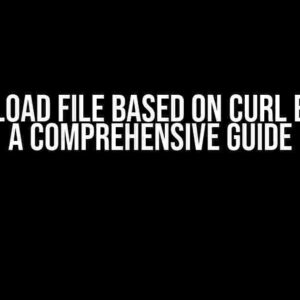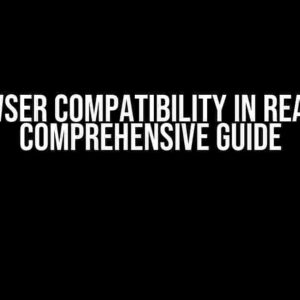Are you tired of the default Tomcat documentation appearing every time you hit your application URL? Do you want to get rid of that unnecessary clutter and keep your web app secure? Well, you’re in luck because today we’re going to show you exactly how to disable default documentation of Tomcat in just a few simple steps.
Why Disable Default Documentation?
Before we dive into the instructions, let’s quickly cover why disabling default documentation is essential:
- Security**: By default, Tomcat documentation provides information about your server, which can be a treasure trove for hackers and malicious users. Disabling it helps keep your server secure.
- Reduced Clutter**: Default documentation can be visually overwhelming and distracting. By disabling it, you can focus on your application’s functionality and user experience.
- Customization**: Disabling default documentation allows you to create a customized landing page or welcome screen that aligns with your brand and application’s identity.
Step 1: Understand the Default Documentation
Before we disable it, let’s understand what we’re dealing with. The default Tomcat documentation consists of several pages, including:
- /docs (Tomcat documentation)
- /examples (Sample applications and examples)
- /manager (Tomcat Manager Web application)
- /host-manager (Host Manager Web application)
These pages are served by the Tomcat server and can be accessed directly using your application’s URL followed by the respective path (e.g., http://localhost:8080/docs).
Step 2: Edit the Tomcat Configuration File
To disable default documentation, we’ll need to edit the Tomcat configuration file. The exact file location may vary depending on your Tomcat installation and operating system. Typically, you can find it in:
/conf/server.xml
Open the file in a text editor and look for the following sections:
<Server>
<Service>
<Connector>...
We'll focus on the <Host> section, which defines the default host and docs application.
Disabling Default Docs Application
To disable the default docs application, add the following line within the <Host> section:
<Host>
<Context path="" docBase=""></Context>
<Context path="/docs" docBase=""></Context>
...
</Host>
This will disable the default docs application and prevent it from being served.
Disabling Examples and Manager Applications
To disable the examples and manager applications, add the following lines within the <Host> section:
<Host>
...
<Context path="/examples" docBase=""></Context>
<Context path="/manager" docBase=""></Context>
<Context path="/host-manager" docBase=""></Context>
</Host>
This will disable the examples and manager applications, preventing them from being accessed.
Step 3: Restart Tomcat Server
After making the changes to the configuration file, restart your Tomcat server to apply the changes:
/bin/shutdown.sh (or shutdown.bat on Windows)
/bin/startup.sh (or startup.bat on Windows)
Alternatively, you can use the Tomcat Manager Web application to restart the server.
Verify the Changes
Open your web browser and navigate to your application URL followed by one of the previously accessible default documentation paths (e.g., http://localhost:8080/docs). You should now see a 404 error page or a custom page of your choice, indicating that the default documentation has been successfully disabled.
Additional Customization
Now that you've disabled the default documentation, you can customize the landing page or welcome screen to suit your application's needs. You can create a new index.html or index.jsp file in the root of your application's document base to serve as the new landing page.
Conclusion
Disabling default documentation of Tomcat is a straightforward process that enhances security and customization of your web application. By following these step-by-step instructions, you can easily disable the default documentation and focus on creating a tailored user experience for your application.
Remember to test your changes thoroughly and ensure that your application is functioning as expected. If you encounter any issues or have further questions, feel free to leave a comment or reach out to us for assistance.
| Tip | Description |
|---|---|
| Regularly Update Tomcat | Stay up-to-date with the latest Tomcat versions to ensure you have the latest security patches and features. |
| Use Strong Passwords | Secure your Tomcat server by using strong passwords for the manager and host-manager applications. |
| Limit Access | Restrict access to the Tomcat server and manager applications to authorized personnel only. |
By following these best practices, you can maintain a secure and efficient Tomcat server for your web application.
Further Reading
If you're interested in learning more about Tomcat configuration and security, we recommend checking out the following resources:
Stay tuned for more tutorials and guides on Tomcat configuration, security, and optimization!
Here are 5 Questions and Answers about "How to disable default documentation of tomcat which comes after hitting application url" with a creative voice and tone:
Frequently Asked Question
Get ready to conquer the Tomcat kingdom by disabling the default documentation that's been holding you back!
Why does Tomcat display default documentation in the first place?
Tomcat displays default documentation to provide users with information about the server and its functionality. However, this documentation can be a security risk and may expose sensitive information about your application. Disabling it is a good practice to ensure the security of your application.
What is the quickest way to disable Tomcat's default documentation?
The quickest way to disable Tomcat's default documentation is to rename or remove the `ROOT.xml` file from the `
Can I disable default documentation for a specific web application only?
Yes, you can disable default documentation for a specific web application by adding an empty `index.html` file to the `WEB-INF` directory of your web application. This will prevent Tomcat from serving the default documentation for that specific application.
Will disabling default documentation affect my application's performance?
Disabling default documentation will not have a significant impact on your application's performance. In fact, it can improve security and reduce the surface area for potential attacks.
Are there any other ways to secure Tomcat besides disabling default documentation?
Yes, there are several other ways to secure Tomcat, including configuring the `server.xml` file, setting up access control lists (ACLs), and using SSL/TLS encryption. It's essential to follow best practices and guidelines for securing Tomcat to ensure the security and integrity of your application.




